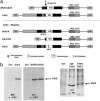Ectopic expression of the homeobox gene Cdx2 is the transforming event in a mouse model of t(12;13)(p13;q12) acute myeloid leukemia
- PMID: 14718672
- PMCID: PMC321764
- DOI: 10.1073/pnas.0305555101
Ectopic expression of the homeobox gene Cdx2 is the transforming event in a mouse model of t(12;13)(p13;q12) acute myeloid leukemia
Abstract
Creation of fusion genes by balanced chromosomal translocations is one of the hallmarks of acute myeloid leukemia (AML) and is considered one of the key leukemogenic events in this disease. In t(12;13)(p13;q12) AML, ectopic expression of the homeobox gene CDX2 was detected in addition to expression of the ETV6-CDX2 fusion gene, generated by the chromosomal translocation. Here we show in a murine model of t(12;13)(p13;q12) AML that myeloid leukemogenesis is induced by the ectopic expression of CDX2 and not by the ETV6-CDX2 chimeric gene. Mice transplanted with bone marrow cells retrovirally engineered to express Cdx2 rapidly succumbed to fatal and transplantable AML. The transforming capacity of Cdx2 depended on an intact homeodomain and the N-terminal transactivation domain. Transplantation of bone marrow cells expressing ETV6-CDX2 failed to induce leukemia. Furthermore, coexpression of ETV6-CDX2 and Cdx2 in bone marrow cells did not accelerate the course of disease in transplanted mice compared to Cdx2 alone. These data demonstrate that activation of a protooncogene by a balanced chromosomal translocation can be the pivotal leukemogenic event in AML, characterized by the expression of a leukemia-specific fusion gene. Furthermore, these findings link protooncogene activation to myeloid leukemogenesis, an oncogenic mechanism so far associated mainly with lymphoid leukemias and lymphomas.
Figures





Similar articles
-
Fusion of ETV6 to the caudal-related homeobox gene CDX2 in acute myeloid leukemia with the t(12;13)(p13;q12).Blood. 1999 Feb 1;93(3):1025-31. Blood. 1999. PMID: 9920852
-
Evidence for position effects as a variant ETV6-mediated leukemogenic mechanism in myeloid leukemias with a t(4;12)(q11-q12;p13) or t(5;12)(q31;p13).Blood. 2002 Mar 1;99(5):1776-84. doi: 10.1182/blood.v99.5.1776. Blood. 2002. PMID: 11861295
-
A novel cryptic translocation t(12;17)(p13;p12-p13) in a secondary acute myeloid leukemia results in a fusion of the ETV6 gene and the antisense strand of the PER1 gene.Genes Chromosomes Cancer. 2003 May;37(1):79-83. doi: 10.1002/gcc.10175. Genes Chromosomes Cancer. 2003. PMID: 12661008
-
The AML1 gene: a transcription factor involved in the pathogenesis of myeloid and lymphoid leukemias.Haematologica. 1997 May-Jun;82(3):364-70. Haematologica. 1997. PMID: 9234595 Review.
-
HOX gene regulation in acute myeloid leukemia: CDX marks the spot?Cell Cycle. 2007 Sep 15;6(18):2241-5. doi: 10.4161/cc.6.18.4656. Epub 2007 Jun 29. Cell Cycle. 2007. PMID: 17881901 Review.
Cited by
-
HOXA9 Reprograms the Enhancer Landscape to Promote Leukemogenesis.Cancer Cell. 2018 Oct 8;34(4):643-658.e5. doi: 10.1016/j.ccell.2018.08.018. Epub 2018 Sep 27. Cancer Cell. 2018. PMID: 30270123 Free PMC article.
-
Beyond Hox: the role of ParaHox genes in normal and malignant hematopoiesis.Blood. 2012 Jul 19;120(3):519-27. doi: 10.1182/blood-2012-02-385898. Epub 2012 Apr 30. Blood. 2012. PMID: 22547580 Free PMC article. Review.
-
Cdx2 Animal Models Reveal Developmental Origins of Cancers.Genes (Basel). 2019 Nov 14;10(11):928. doi: 10.3390/genes10110928. Genes (Basel). 2019. PMID: 31739541 Free PMC article. Review.
-
The Cross Marks the Spot: The Emerging Role of JmjC Domain-Containing Proteins in Myeloid Malignancies.Biomolecules. 2021 Dec 20;11(12):1911. doi: 10.3390/biom11121911. Biomolecules. 2021. PMID: 34944554 Free PMC article. Review.
-
Cdx gene deficiency compromises embryonic hematopoiesis in the mouse.Proc Natl Acad Sci U S A. 2008 Jun 3;105(22):7756-61. doi: 10.1073/pnas.0708951105. Epub 2008 May 29. Proc Natl Acad Sci U S A. 2008. PMID: 18511567 Free PMC article.
References
-
- Rowley, J. D. (1999) Semin. Hematol. 36, 59–72. - PubMed
-
- Bohlander, S. K. (2000) Cytogenet. Cell Genet. 91, 52–56. - PubMed
-
- Look, A. T. (1997) Science 278, 1059–1064. - PubMed
-
- Pineault, N., Buske, C., Feuring-Buske, M., Abramovich, C., Rosten, P., Hogge, D. E., Aplan, P. D. & Humphries, R. K. (2003) Blood 101, 4529–4538. - PubMed
Publication types
MeSH terms
Substances
LinkOut - more resources
Full Text Sources
Medical
Molecular Biology Databases
Research Materials

